Understanding the Trick Duties and Obligations in Medical Administration
Understanding the Trick Duties and Obligations in Medical Administration
Blog Article
Innovations in Medical Management: How Modern Technology Is Reshaping Health Care Administration
The landscape of health care administration is undergoing a profound makeover, driven by technological innovations in medical administration. Electronic Health And Wellness Records (EHR) have become the foundation of effective patient information administration, while telemedicine bridges distances, making healthcare obtainable to also one of the most remote places. Fabricated intelligence is not just a futuristic principle but a contemporary device that personalizes client treatment and simplifies administrative jobs. As these developments take facility stage, a crucial inquiry arises: how will these technologies better redefine the healthcare experience for both carriers and individuals in the coming years?
Development of Electronic Wellness Records
Over the past couple of decades, the advancement of electronic wellness records (EHRs) has actually considerably transformed the landscape of medical administration. Initially created to digitize patient records, EHRs have actually increased past their original range to come to be essential devices in simplifying healthcare procedures, enhancing person treatment, and enhancing administrative efficiencies. The change from paper-based systems to EHRs has reduced redundancies, reduced mistakes, and helped with seamless information sharing throughout various health care companies, consequently enabling extensive and worked with patient treatment.
EHRs have introduced a standard shift in healthcare monitoring by incorporating medical, administrative, and economic data, thus permitting more enlightened decision-making. The accessibility of real-time individual information empowers healthcare specialists to make prompt analysis and treatment decisions, additionally boosting patient end results. Furthermore, EHRs sustain the implementation of evidence-based techniques by providing accessibility to the current clinical study and therapy standards straight within the clinical process.
The federal incentives and guidelines have actually increased EHR adoption, guaranteeing conformity with criteria that guard person personal privacy and information protection. As the healthcare industry continues to welcome electronic change, EHRs remain at the leading edge of technology, driving effectiveness and enhancing the general top quality of healthcare delivery.
Advancements in Telemedicine
Telemedicine has rapidly progressed in the last few years, essentially changing the means medical care solutions are provided. This makeover is largely attributed to technical developments that have increased access to medical care, especially for individuals in remote or underserved areas. Telemedicine platforms facilitate real-time assessments in between people and doctor, therefore decreasing the requirement for in-person check outs and substantially decreasing wait times.
The integration of video clip conferencing, mobile health applications, and remote monitoring tools has actually boosted the range of telemedicine. Patients can currently manage persistent problems with continual surveillance, receive timely examinations, and gain access to expert care without geographical restraints. This change has not only enhanced patient satisfaction but has actually also maximized medical care process and resource allowance.
Furthermore, telemedicine has actually played a vital role in public health and wellness, particularly throughout pandemics, by minimizing the risk of transmittable condition transmission. Regulative advancements have additionally supported telemedicine's proliferation, with numerous nations revising plans to permit wider insurance policy coverage for online brows through.
Regardless of challenges such as electronic proficiency and data security, the continuous growth of telemedicine assures to maintain its trajectory as a keystone of modern medical care management, providing an extra obtainable and efficient health care distribution version.
Artificial Intelligence in Health Care
Building on the technical innovations seen in telemedicine, man-made intelligence (AI) is rapidly coming to be a transformative pressure in medical care management. AI modern technologies supply substantial enhancements in efficiency, accuracy, and decision-making capabilities. One of the most engaging applications of AI in health care is predictive analytics, which enables health care administrators to prepare for person requirements, streamline resource appropriation, and improve patient results. By assessing big datasets, AI formulas can recognize patterns and predict possible wellness crises, enabling proactive intervention.

Another significant application remains in tailored medication, where AI assists in tailoring therapies to individual person profiles by analyzing genetic, way of life, and environmental aspects (medical administration). As AI remains to develop, its assimilation right into healthcare administration assures to enhance procedures, minimize expenses, and inevitably enhance the top quality of care given
Enhancing Information Safety And Security Procedures
As healthcare companies significantly depend on digital systems for managing client data, the demand for robust data security procedures has grown significantly. Data violations not only jeopardize individual personal privacy however likewise lead to significant financial losses and damages to institutional credibilities.
Health care institutions are executing multi-layered have a peek at these guys safety structures to reduce dangers. Security innovations make sure that sensitive information continues to be inaccessible to unauthorized users, both throughout transmission and storage space. In addition, the fostering of blockchain technology presents a promising avenue for boosting information integrity and traceability, giving an immutable record of all deals.

Training staff on cybersecurity ideal practices is just as necessary. Recognition programs gear up healthcare personnel with the expertise to acknowledge and report possible hazards, such as phishing efforts. By focusing on data security, medical managements can shield person details and preserve trust.
Improving Person Communication Equipment
While robust information protection measures are fundamental in safeguarding client details, similarly essential is the enhancement of client interaction systems to guarantee effective healthcare delivery. In the evolving landscape of medical care administration, technological browse around this site innovations are playing an essential function in changing just how doctor engage with clients. Reliable interaction systems not only boost person complete satisfaction but also improve professional results by ensuring prompt and exact details exchange.
Among the considerable innovations around is the assimilation of electronic health documents (EHR) with person websites. This assimilation enables patients to access their medical info safely, routine appointments, and interact with doctor effectively. Furthermore, the use of telemedicine systems has actually broadened accessibility to medical care services, specifically for those in remote locations or with wheelchair difficulties. These platforms promote real-time consultations, lowering the demand for physical check outs and making it possible for continual care monitoring.
Furthermore, artificial intelligence-powered chatbots are being significantly utilized to supply instant actions to patient queries, offering a smooth interaction experience. By leveraging these technical advancements, healthcare suppliers can cultivate more personalized person interactions, inevitably leading to enhanced person involvement and adherence to therapy plans.
Conclusion
Technological developments in clinical administration are essentially changing healthcare management by incorporating sophisticated devices such as Electronic Health Records, telemedicine, and expert system. These innovations simplify administrative processes, boost data accuracy, and enable real-time access to individual details, thus improving decision-making. Telemedicine raises medical care availability for remote populations, while man-made intelligence automates jobs and customizes individual interaction. Jointly, these improvements drive effectiveness, minimize this link costs, and raise the high quality of medical care distribution, improving business operations in the health care industry.
Report this page